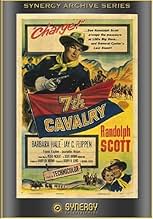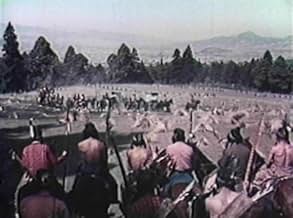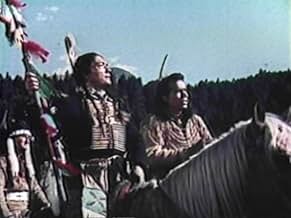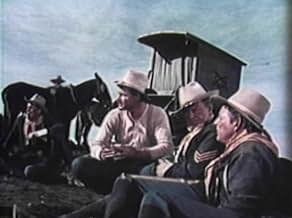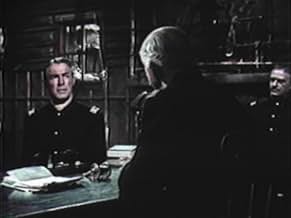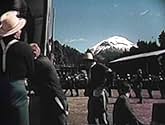AVALIAÇÃO DA IMDb
5,8/10
1,5 mil
SUA AVALIAÇÃO
Adicionar um enredo no seu idiomaAn officer accused of cowardice volunteers to bring back General Custers's body after Little Big Horn.An officer accused of cowardice volunteers to bring back General Custers's body after Little Big Horn.An officer accused of cowardice volunteers to bring back General Custers's body after Little Big Horn.
- Direção
- Roteiristas
- Artistas
Bill Clark
- Soldier With Kellogg
- (não creditado)
Charles Horvath
- Knife-Wielding Indian
- (não creditado)
William Leslie
- Lt. Murray
- (não creditado)
Harold Miller
- Officer at Inquiry
- (não creditado)
- Direção
- Roteiristas
- Elenco e equipe completos
- Produção, bilheteria e muito mais no IMDbPro
Avaliações em destaque
Captain Benson (Randolph Scott) returns from the east with his new bride-to-be (played ably enough by Barbara Hale) only to find out that his post under General Custer was wiped out at the Battle of the Little Bighorn. The men who were left behind at the post resent Benson because he wasn't there to die gallantly with the rest of his troop.
A presidential order is given for the army to go into Sioux territory and gather up Custer's dead for burial. Benson quickly volunteers for such a dangerous mission, probably to redeem himself. After all, the Big Horn is still surrounded by hostile Sioux and Cheyenne, drunk with victory.
When Benson and his men reach the site, they find that the Indians won't let them un-bury the dead because it is now considered sacred ground and not to be violated. That is, until Custer's riderless horse strolls into view, scaring all the Indians into thinking it's bad medicine and Custer's spirit has returned.
There's a subplot about how this horse came onto the scene involving Harry Carey Jr. and all, but I'm not gonna get into that. Anyway, the Indians are plenty superstitious about the whole thing so they allow Benson and his men to pass, unscathed.
Although it's nowhere near as good as the oaters Scott did with Budd Boetticher, this one nonetheless still rises above most of the other western dreck Harry Cohn and Columbia Pictures was putting out. It also helps filming it out in the California pine country away from the usual Columbia ranch locations that we've seen a zillion times before. It still doesn't pass for the plains, though.
Still, it's better than most of Scott's RKO westerns from the late 40s
5 out of 10
A presidential order is given for the army to go into Sioux territory and gather up Custer's dead for burial. Benson quickly volunteers for such a dangerous mission, probably to redeem himself. After all, the Big Horn is still surrounded by hostile Sioux and Cheyenne, drunk with victory.
When Benson and his men reach the site, they find that the Indians won't let them un-bury the dead because it is now considered sacred ground and not to be violated. That is, until Custer's riderless horse strolls into view, scaring all the Indians into thinking it's bad medicine and Custer's spirit has returned.
There's a subplot about how this horse came onto the scene involving Harry Carey Jr. and all, but I'm not gonna get into that. Anyway, the Indians are plenty superstitious about the whole thing so they allow Benson and his men to pass, unscathed.
Although it's nowhere near as good as the oaters Scott did with Budd Boetticher, this one nonetheless still rises above most of the other western dreck Harry Cohn and Columbia Pictures was putting out. It also helps filming it out in the California pine country away from the usual Columbia ranch locations that we've seen a zillion times before. It still doesn't pass for the plains, though.
Still, it's better than most of Scott's RKO westerns from the late 40s
5 out of 10
This scheme is for Randolph Scott what THE MAN FROM ALAMO was for Glenn Ford. Remember this Universal Studios western where Glenn Ford was accused of being a coward and escaped from Alamo slaughter? So replace Alamo by Little Big Horn, two battles that Americans lost, and you have an idea of what you deal with here. This is not my favorite from director Joseph Lewis, it could have been from André De Toth, but not from Budd Boetticher though. Because Boetticher and Lewis had their own trademark. Here, the plot, directing, camera work, are rather common, nothing to remember of. Nothing in particular, I mean. Good western not more.
At 58, Scott was just too old for the role. Not just being only a Captain, but still in cavalry. Not realistic he would have physicality for the activity his character displays.
Captain Thomas Benson returns to Fort Lincoln, the Seventh Cavalry's outpost in the Dakota wilderness, with Martha Kellogg, his bride-to-be. As the couple approach the fort, it is apparent that something is wrong. Benson enters to find the Seventh Cavalry's base strangely silent and motionless. Unknown to Benson, while he has been away General Custer has led the regiment to disaster at the Little Big Horn ...
The stillness and emptiness of the fort could serve as a metaphor for the film's lack of pace and content. The first half consists of endless breast-beating over the recent disaster, and the cavalrymen's torpid dialogue is unrelieved by motion or variety of any kind. It is fully 45 minutes before anything remotely resembling an action sequence occurs.
Benson is regarded with contempt by the remnants of the Seventh, both because he was Custer's favourite and because he managed to avoid the Little Big Horn. Matters are complicated by his choice of fiancee. Martha (Barbara Hale) is the daughter of Colonel Kellogg, the new commander of the regiment, and the man charged with investigating the recent military debacle.
A mundane and leaden horse opera, "Seventh Cavalry" lacks either a coherent structure, interesting action or even a convincing raison d'etre. Benson decides to rehabilitate himself by leading a burial detail out into the battlefield to recover the regiment's dead. He deliberately chooses the drunks and the shirkers, but it is never explained why these men, reluctant soldiers at the best of times, agree to be 'volunteered' for this dangerous work. Once in open terrain, Benson deserts his command to go chasing after a lone indian scout, in flagrant dereliction of his duty. During the pursuit, the two men ride past the same tree stump twice! They fight hand-to-hand, and Benson uses a stick to trap the indian's knife-wielding right hand. Why doesn't the indian simply transfer the knife to his free left hand?
The widow Mrs. Reynolds wails like a soothsayer in the deserted barracks, but neither her text nor her acting carry any conviction. The returning survivors of the Little Big Horn ride into Fort Lincoln, hamming up the weariness and weakness for all they are worth - but where did they acquire the neat, clean bandages? When Benson fights with the loud-mouth Vogel, the scrap is all too obviously conducted by stunt doubles. Even an indian who has been brought up by white folk is unlikely to come out with preposterous lines such as "You are defiling sacred ground". The film's ending is a cheap and hurried reconciliation between the Kelloggs and Benson, shot in an interior to save time and effort.
Randolph Scott was Associate Producer of this piece of nonsense, as well as starring as Benson (despite being patently too old for the part). If one scrabbles around for aspects of the film which deserve praise, one could commend Donald Curtis for his believable Lieutenant Fitch, and the fort set, which is huge and impressive. But that's it.
Verdict - too much talking, not enough motion.
The stillness and emptiness of the fort could serve as a metaphor for the film's lack of pace and content. The first half consists of endless breast-beating over the recent disaster, and the cavalrymen's torpid dialogue is unrelieved by motion or variety of any kind. It is fully 45 minutes before anything remotely resembling an action sequence occurs.
Benson is regarded with contempt by the remnants of the Seventh, both because he was Custer's favourite and because he managed to avoid the Little Big Horn. Matters are complicated by his choice of fiancee. Martha (Barbara Hale) is the daughter of Colonel Kellogg, the new commander of the regiment, and the man charged with investigating the recent military debacle.
A mundane and leaden horse opera, "Seventh Cavalry" lacks either a coherent structure, interesting action or even a convincing raison d'etre. Benson decides to rehabilitate himself by leading a burial detail out into the battlefield to recover the regiment's dead. He deliberately chooses the drunks and the shirkers, but it is never explained why these men, reluctant soldiers at the best of times, agree to be 'volunteered' for this dangerous work. Once in open terrain, Benson deserts his command to go chasing after a lone indian scout, in flagrant dereliction of his duty. During the pursuit, the two men ride past the same tree stump twice! They fight hand-to-hand, and Benson uses a stick to trap the indian's knife-wielding right hand. Why doesn't the indian simply transfer the knife to his free left hand?
The widow Mrs. Reynolds wails like a soothsayer in the deserted barracks, but neither her text nor her acting carry any conviction. The returning survivors of the Little Big Horn ride into Fort Lincoln, hamming up the weariness and weakness for all they are worth - but where did they acquire the neat, clean bandages? When Benson fights with the loud-mouth Vogel, the scrap is all too obviously conducted by stunt doubles. Even an indian who has been brought up by white folk is unlikely to come out with preposterous lines such as "You are defiling sacred ground". The film's ending is a cheap and hurried reconciliation between the Kelloggs and Benson, shot in an interior to save time and effort.
Randolph Scott was Associate Producer of this piece of nonsense, as well as starring as Benson (despite being patently too old for the part). If one scrabbles around for aspects of the film which deserve praise, one could commend Donald Curtis for his believable Lieutenant Fitch, and the fort set, which is huge and impressive. But that's it.
Verdict - too much talking, not enough motion.
Returning to Fort Lincoln, Captain Benson (Randolph Scott) learns of Custer's defeat at the Little Big Horn. Meanwhile, Benson carries his girlfriend ,Martha Kellogg (Barbara Hale), to the fort commanded by Col. Kellogg (Russell Hicks) who's Martha's father. Benson who was branded a coward for not taking part in the festivities attempts to assuage his guilt by heading up the burial detail, along with a group drunks and misfits (Leo Gordon, Denver Pyle, Harry Carey Jr, Frank Faylen) . At the inquiry as Custer's Officers blame Custer for the defeat, Benson tries to defend him. But Benson was suspiciously absent at the time of the battle and is now despised by the troops. So when an order to retrieve the bodies from the battlefield arrives, Benson volunteers for the dangerous mission of returning back into Indian territory. Charging the battle lines of the Sioux and the Cheyennes !. "Charge!"...See Randolph Scott avenge the massacre at Little Big Horn...and General Custer's Last Stand!
The film depicts a somewhat different look at Custer's defeat at the Little Big Horn, here an officer accused of cowardice volunteers to bring back General Custers's body after Little Big Horn. The muddled ending tries to tell us that the Indians were afraid of Custer's horse. One of Joseph H Lewis' two colour movies, a weird and occasionally enjoyable little Western focusing on the enmity between white and red man as Scott, accused of deserting Custer out of cowardice during the fiasco of Little Big Horn, sets out to discover the truth of the massacre. The film is acceptable and decent enough, being beautifully filmed and briskly paced. It's most interesting for a surprising anti-Custer stance, and for its surreal, almost supernatural event, which sees Custer's horse showing up like a ghost from the wilderness to allegedly bring peace between enemies. Stars Randolph Scott who gives a nice acting in his usual style as a cavalry officer accused of cowardice and is placed in charge of rebel soldiers detailed to bury the dead after the onslaught. In 7th Cavalry (1956) stands out a splendid plethora of secondaries at the time, such as: Jay C. Flippen, Frank Faylen, Jeanette Nolan, Leo Gordon, Denver Pyle, Harry Carey Jr. , Michael Pate, Pat Hogan, Russell Hicks, Frank Wilcox, Donald Curtis and Frank Hogan.
This Western is just a shade different thanks to Peter Parker's script and especially to the shooting of Joseph H Lewis, though nothing special. Professionally directed by Joseph H Lewis who chooses all the right angles for a real impact and never puts a wrong foot. He never really rose above the second feature, but turned in some fine work within the genre. During two decades, Lewis spent time at Columbia (1939-40, 1946-49), Universal again (1942), PRC (1944), MGM (1950, 1952-53) and United Artists (1957-58), reliably turning out a couple of pictures per year. While he helmed more than his fair share of horse operas, it was invariably his films noir which attracted the most attention. Lewis was a B craftsman who directed a lot of films of all kinds of genres with a penchant for Noir movies, as he made Drama, Thriller, Action, Western such as Terror in a Texas town, 7th cavalry, The Halliday brand, A lawless street, Cry of the hunted, Retreat hell, Desperate search , A lady without passport, The undercover man, So dark the night, My name is Julia Ross, The mad doctor of Market Street, The gang of mine and his greatest hits were The Big Combo and Gun Crazy . He spent a few more years directing episodic TV westerns (including several of the better episodes of The Rifleman (1958) and finally retired in 1966. Rating 6/10. Essential and indispensable watching for Western enthusiasts and Randolph Scott fans.
The film depicts a somewhat different look at Custer's defeat at the Little Big Horn, here an officer accused of cowardice volunteers to bring back General Custers's body after Little Big Horn. The muddled ending tries to tell us that the Indians were afraid of Custer's horse. One of Joseph H Lewis' two colour movies, a weird and occasionally enjoyable little Western focusing on the enmity between white and red man as Scott, accused of deserting Custer out of cowardice during the fiasco of Little Big Horn, sets out to discover the truth of the massacre. The film is acceptable and decent enough, being beautifully filmed and briskly paced. It's most interesting for a surprising anti-Custer stance, and for its surreal, almost supernatural event, which sees Custer's horse showing up like a ghost from the wilderness to allegedly bring peace between enemies. Stars Randolph Scott who gives a nice acting in his usual style as a cavalry officer accused of cowardice and is placed in charge of rebel soldiers detailed to bury the dead after the onslaught. In 7th Cavalry (1956) stands out a splendid plethora of secondaries at the time, such as: Jay C. Flippen, Frank Faylen, Jeanette Nolan, Leo Gordon, Denver Pyle, Harry Carey Jr. , Michael Pate, Pat Hogan, Russell Hicks, Frank Wilcox, Donald Curtis and Frank Hogan.
This Western is just a shade different thanks to Peter Parker's script and especially to the shooting of Joseph H Lewis, though nothing special. Professionally directed by Joseph H Lewis who chooses all the right angles for a real impact and never puts a wrong foot. He never really rose above the second feature, but turned in some fine work within the genre. During two decades, Lewis spent time at Columbia (1939-40, 1946-49), Universal again (1942), PRC (1944), MGM (1950, 1952-53) and United Artists (1957-58), reliably turning out a couple of pictures per year. While he helmed more than his fair share of horse operas, it was invariably his films noir which attracted the most attention. Lewis was a B craftsman who directed a lot of films of all kinds of genres with a penchant for Noir movies, as he made Drama, Thriller, Action, Western such as Terror in a Texas town, 7th cavalry, The Halliday brand, A lawless street, Cry of the hunted, Retreat hell, Desperate search , A lady without passport, The undercover man, So dark the night, My name is Julia Ross, The mad doctor of Market Street, The gang of mine and his greatest hits were The Big Combo and Gun Crazy . He spent a few more years directing episodic TV westerns (including several of the better episodes of The Rifleman (1958) and finally retired in 1966. Rating 6/10. Essential and indispensable watching for Western enthusiasts and Randolph Scott fans.
Você sabia?
- CuriosidadesThe surname 'Kellogg' is used for two characters in the film - the colonel and his daughter Martha. It is also the surname of Mark Kellogg, a newspaper reporter who rode with Custer's troops. He was killed at the Battle of the Little Big Horn.
- Erros de gravaçãoAs Corporal Morrison (Harry Carey Jr.) saddles "Dandy", Lt. Col. Custer's second mount, he puts on an English saddle. US Calvary adopted McClellan saddles which remained in service through World War II. This was the wrong saddle for the movie.
- Citações
[first lines]
Capt. Tom Benson: We'll be able to see the fort from the top of the next rise.
[Tom and Martha ride a little farther]
Capt. Tom Benson: There she is - Fort Lincoln, the base of the finest cavalry regiment in the country - and our home.
- Cenas durante ou pós-créditosOpening credits: Capt. Benson was returning with his future bride, to his post commanded by the gallant Indian fighter Colonel Custer, who had prepared the famous 7th for all out war with the Sioux.
Principais escolhas
Faça login para avaliar e ver a lista de recomendações personalizadas
- How long is 7th Cavalry?Fornecido pela Alexa
Detalhes
- Data de lançamento
- País de origem
- Idioma
- Também conhecido como
- El fantasma de la batalla
- Locações de filme
- Empresas de produção
- Consulte mais créditos da empresa na IMDbPro
- Tempo de duração1 hora 15 minutos
- Proporção
- 1.85 : 1
Contribua para esta página
Sugerir uma alteração ou adicionar conteúdo ausente

Principal brecha
By what name was O Fantasma do General Custer (1956) officially released in India in English?
Responda

